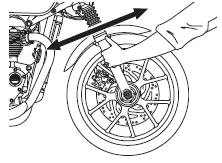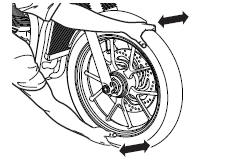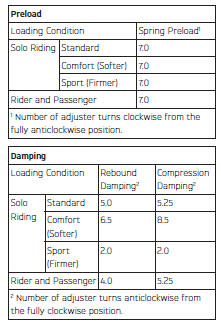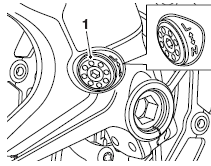 Triumph Street Scrambler - Owner's Manual > Steering/Wheel Bearings
Triumph Street Scrambler - Owner's Manual > Steering/Wheel Bearings
Warning
To prevent risk of injury from the motorcycle falling during the inspection, make sure that the motorcycle is stabilised and secured on a suitable support.
Do not exert extreme force against each wheel or rock each wheel vigorously as this may cause the motorcycle to become unstable and cause injury by falling from its support.
Make sure that the position of the support block will not cause damage to the motorcycle.
Steering Inspection
Warning
Riding the motorcycle with incorrectly adjusted or defective steering (headstock) bearings is dangerous and may cause loss of motorcycle control and an accident.
Note:
Always inspect the wheel bearings at the same time as the steering bearings.
Lubricate and inspect the condition of the steering (headstock) bearings in accordance with scheduled maintenance requirements.

Inspecting the Steering for Free Play
To inspect the steering: Position the motorcycle on level ground, in an upright position.
Raise the front wheel above the ground and support the motorcycle.
Standing at the front of the motorcycle, hold the lower end of the front forks and try to move them forward and backward.
If any free play can be detected in the steering (headstock) bearings, ask your authorised Triumph dealer to inspect and rectify any faults before riding.
Remove the support and place the motorcycle on the side stand.
Wheel Bearings Inspection
Warning
Riding with worn or damaged front or rear wheel bearings is dangerous and may cause impaired handling and instability leading to an accident. If in doubt, have the motorcycle inspected by an authorised Triumph dealer before riding.
If the wheel bearings in the front or rear wheel allow play in the wheel hub, are noisy, or if the wheel does not turn smoothly, have your authorised Triumph dealer inspect the wheel bearings.
The wheel bearings must be inspected at the intervals specified in the scheduled maintenance chart.

Inspecting the Wheel Bearings
To inspect the wheel bearings: Position the motorcycle on level ground, in an upright position.
Raise the front wheel off the ground and support the motorcycle.
Standing at the side of the motorcycle, gently rock the top of the front wheel from side to side.
If any free play can be detected, ask your authorised Triumph dealer to inspect and rectify any faults before riding.
Reposition the lifting device and repeat the procedure for the rear wheel.
Remove the support and place the motorcycle on the side stand.
Front Suspension - Front Fork Inspection
Warning
Riding the motorcycle with defective or damaged suspension is dangerous and may lead to loss of control and an accident.
Warning
Never attempt to dismantle any part of the suspension units, as all units contain pressurised oil. Skin and eye damage can result from contact with the pressurised oil.

Street Twin Shown
Examine each fork for any sign of damage, scratching of the slider surface, or for oil leaks.
If any damage or leakage is found, consult an authorised Triumph dealer.
To check that the forks operate smoothly: Position the motorcycle on level ground.
While holding the handlebars and applying the front brake, pump the forks up and down several times.
If roughness or excessive stiffness is detected, consult your authorised Triumph dealer.
Front Suspension Adjustment
The Thruxton R is fitted with adjustable front suspension.
All other models have non-adjustable front suspension.
Front Suspension Settings - Thruxton R
Warning
Make sure that the adjusters are set to the same setting on both front suspension units. Settings that vary from left to right may affect handling and stability resulting in loss of motorcycle control and an accident.
Warning
Make sure that the correct balance between front and rear suspension is maintained. Suspension imbalance could significantly change handling characteristics leading to loss of control and an accident. Refer to the table for further information or consult your authorised Triumph dealer.

Note:
This chart is only a guide. Setting requirements may vary for rider weight and personal preferences.
See the following pages for information regarding suspension adjustment.
The standard suspension setting provides a comfortable ride and good handling characteristics for general, solo riding. The chart shows suggested settings for the front suspension.
Front Suspension Preload Adjustment - Thruxton R Only

- Front suspension preload adjuster
The preload adjuster is located at the bottom of the front suspension unit.
To change the preload: Rotate the adjuster clockwise to increase, or anticlockwise to decrease using the adjustment tool located in the right hand side panel.
Always count the number of turns from the fully clockwise position.
Note:
The motorcycle is delivered from the factory with the preload adjuster set at the Standard setting, as shown in the relevant suspension chart
Front Suspension Rebound and Compression Damping Adjustment - Thruxton R Only

Front suspension rebound and compression damping adjusters
The rebound and compression damping adjusters are located at the top of each fork.
To change the rebound damping setting: Rotate the TEN slotted adjuster clockwise to increase, or anticlockwise to decrease.
To change the compression damping setting: Rotate the COM slotted adjuster clockwise to increase, or anticlockwise to decrease.
Always count the number of turns from the fully clockwise position.
Note:
The motorcycle is delivered from the factory with the rebound and compression damping adjusters set at the Standard setting, as shown in the relevant suspension chart
See also:
 Triumph Street Scrambler - Owner's Manual > Brakes
Triumph Street Scrambler - Owner's Manual > Brakes
Brake pads Minimum thickness line Brake pads must be inspected in accordance with scheduled maintenance requirements and replaced if worn to, or beyond the minimum service thickness.
 Triumph Street Scrambler - Owner's Manual > Rear Suspension
Triumph Street Scrambler - Owner's Manual > Rear Suspension
Note: Street Twin, Street Cup, Street Scrambler, Thruxton, Bonneville T100 and Bonneville T120 suspension settings are spring preload adjustable only. Thruxton R suspension has three different rear adjustment settings; spring preload, rebound damping and compression damping.
 Ducati Scrambler
Ducati Scrambler Fantic Caballero 500
Fantic Caballero 500 Indian FTR 1200
Indian FTR 1200 Moto Guzzi V85 TT
Moto Guzzi V85 TT Royal Enfield Bullet Trials Works Replica
Royal Enfield Bullet Trials Works Replica Triumph Scrambler 1200 XE
Triumph Scrambler 1200 XE Triumph Street Scrambler
Triumph Street Scrambler Yamaha XSR700
Yamaha XSR700 Ducati Scrambler 800
Ducati Scrambler 800 Moto Guzzi V85 TT
Moto Guzzi V85 TT Triumph Scrambler 1200 XC
Triumph Scrambler 1200 XC